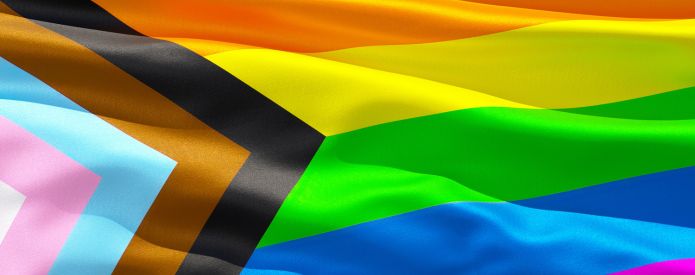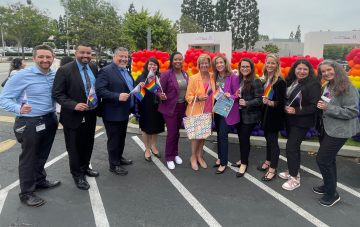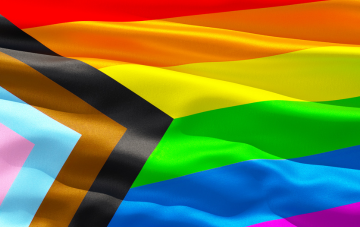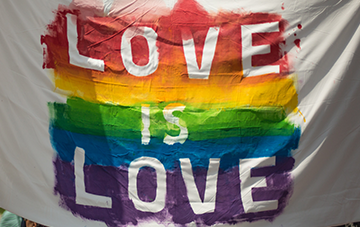LACOE is committed to creating inclusive and affirming environments for LGBTQIA+ educators, students and staff across L.A. County.
This section provides a collection of resources, tools and information to promote understanding, acceptance and equality of LGBTQIA+ people. These resources will assist you in establishing and fostering a safe and inclusive community for LGBTQIA+ individuals.
Learn more about the LGBTQIA+ community, allyship and how to help educate yourself and others to be more inclusive and understanding.
LACOE is working towards creating an inclusive and affirming environment through education. We believe that everyone deserves to be seen, heard, valued, and treated with respect and dignity, and we hope that you will join us in celebrating and embracing diversity in all its forms.
Pronouns are an essential aspect of how we express ourselves and how we wish to be addressed by others. Using someone's pronouns is a way to respect their self-identified gender and affirm and validate their identity. It demonstrates empathy, understanding, a commitment to equality and contributes to a more inclusive and accepting society. Learn more about gender, sexual orientation and pronouns.
LGBTQIA+
The term LGBTQIA+ is an acronym that stands for:
- Lesbian
- Gay
- Bisexual
- Transgender
- Queerand/or Question
- Intersex
- Asexual
- + other identities
The LGBTQIA+ community is a diverse community that is united by the common goal of advocating for equal rights and acceptance for all individuals, regardless of their sexual orientation,gender identityand/or gender expression.
Gender Spectrum
One of the fundamental concepts within the LGBTQIA+ community is the gender spectrum. The gender spectrum is a way of understanding that gender is not binary, meaning that it is not just male or female. Instead, it is a continuum with many different identities, expressions, and experiences.
Some people identify as:
- Cisgender, which means that their gender identity aligns with the sex they were assigned at birth.
- Transgender, which means that their gender identity does not align with the sex they were assigned at birth.
- Non-binary, for people who do not identify as either male or female
- Genderfluid, for people who may identify as male, female, both, or neither at different times.
SOGIE
- Sexual Orientation: describes to whom a person is attracted.
- Gender Identity and Expression: describes the way in which a person identifies and/or expresses their gender.
Pronouns
Understanding and respecting gender pronouns is also incredibly important. Pronouns are the words we use to refer to someone when we are not using their name:
- Woman/girl: "she/her"
- Man/boy: "he/him"
- Gender-neutral: "they/them"
- Neopronouns:"ze/hir”
Using the correct pronouns is an essential part of respecting and affirming someone's gender identity. It'simportant to note that personal pronouns should not be assumed based on someone's appearance or gender expression. Therefore, it's crucial to ask individuals what their preferred pronouns are and to use them consistently.
Misgendering someone can be hurtful and invalidating, so taking the time to learn and use the correct pronouns is a crucial step in creating a more inclusive and welcoming environment for everyone.
Resources:
- GLAAD – LGBTQ+ Resource List
- GLAAD – Glossary of Terms: LGBQT+
- The Trevor Project: – Resources
- Pronouns.org – What and Why
- Pronouns.org – Resources
- Human Rights Campaign – Pronouns 101
Supporting LGBTQIA+ Youth
At least 10 percent of California students in middle and high school grades identify as Lesbian, Gay, Bisexual, Transgender, Queer, Intersex or Asexual (LGBTQIA+)1. Visibility, a sense of safety and belonging are essential aspects of inclusive learning and working environments where all students, families and staff see themselves as a part of their school, work and communities. Where all students feel loved and cared for. Where all students feel safe and welcome.
According to the GLSEN 2019 National School Climate Survey, more than 86 percent of LGBTQ+ students experienced harassment or assault based on personal characteristics (such as sexual orientation, gender expression, perceived religion, actual or perceived race, ethnicity, or disability), and nearly a fifth of LGBTQ+ students reported changing schools due to feeling unsafe or uncomfortable at school. In February 2023, the Centers for Disease Control and Prevention released results from its 2021 Youth Risk Behavior Survey, which showed high levels of violence, depression, and suicidal thoughts among lesbian, gay, and bisexual youth. According to the findings, more than one in five of these students reported attempting suicide in the year before the survey. At least 52 percent of teenagers who identified as gay, lesbian, bisexual, or questioning said they struggled with mental health.
The Importance of Supporting LGBQTIA+ Students
Supporting our LGBTQIA+ students is essential for wellbeing and academic success. When students feel safe, seen and accepted, they are more likely to thrive in school. Here are some reasons why educators should actively support LGBTQIA+ students:
Mental Health: Research shows LGBTQIA+ students are at a higher risk for mental health issues, including depression and anxiety. According to the Trevor Project, LGBTQIA+ youth who report having at least one accepting adult were 40% less likely to report a suicide attempt in the past year. Your support can make a significant difference in their emotional well-being.
Academic Achievement: A supportive environment positively impacts academic performance. LGBTQIA+ students who feel accepted are more likely to excel in their studies.
Reducing Bullying: LGBTQIA+ students often face higher rates of bullying and harassment. Educators can help create a culture of respect and inclusion that combats hate and discrimination.
LGBTQIA+ Discrimination
The LBGTQIA+ community triumphs over systemic discrimination by fostering inclusivity and celebrating diversity in all its vibrant forms. By embracing acceptance and understanding, we create a world where the potential for positive change is boundless, empowering individuals to thrive and reach their full potential.
The Importance of Allyship
Discrimination against LGBTQIA+ people is still a widespread issue, with many facing harassment, violence, and discrimination. By actively supporting and advocating for LGBTQIA+ individuals, allies can help to counteract the negative effects of discrimination. Allies can help create safe and welcoming environments for LGBTQIA+ people, promote understanding and acceptance of LGBTQIA+ identities, and advocate for policies and laws that protect and promote LGBTQIA+ rights. Additionally, allyship can help to build bridges between different communities and foster greater empathy and understanding.
As an ally, heterosexual and/or cisgender person may show support and advocacy for LGBTQIA+ people. Plural is allies. Being an ally involves active engagement and continuous learning to create inclusive spaces, challenge stereotypes and stand up against discrimination. Below are a few active steps you can take today to demonstrate allyship:
- Add your pronouns to your email signature.
- Share your pronouns when introducing yourself to new friends or colleagues.
- If you hear an anti-LGBTQIA+ comment or joke, be an upstander: speak up and explain why such comments or jokes are harmful and offensive.
- Integrate inclusive language into your regular conversations and interactions with family, friends, colleagues and strangers.
- Place a supportive symbol or sign in your office, home or on your vehicle.
Source: Human Rights Campaign – Report: Being an LGBTQ+ Ally
Progress Pride Flag
The Progress Pride Flag was created in 2018 by nonbinary artist Daniel Quasar. The design includes black and brown stripes to represent LGBTQIA+ people of color, the colors pink, blue, and white to represent transgender people and an arrow pointing to the right to symbolize forward movement.
The Progress Pride flag is a powerful symbol of inclusivity and diversity within the LGBTQIA+ community.
Please find resources below to support you in providing safe learning environments that protect the health and safety of LGBTQ+ students:
Resources for Educators
The California Department of Education (CDE) provides instructional guidance, law and policies for local educational agencies to support LGBTQIA+ students and provide safe learning environments that protect the health and safety of LGBTQ+ students.
- See resource: https://www.cde.ca.gov/pd/ee/supportlgbtq.asp
- Los Angeles County-specific resources can be found here: https://www.cde.ca.gov/pd/ee/region11.asp
GLSEN has activities for all grade levels to help educators integrate LGBTQIA+ history, people and issues into their instructional programs.
This toolkit can support youth-serving professionals, educators, and clinicians in ensuring that LGBTQ+ youth, especially youth of color, are affirmed and validated in their organizations.
- See resource: Creating Safer Spaces For LGBTQ Youth: A Toolkit for Education, Healthcare, And Community-based Organizations
This guide is geared toward the needs of all students, K-12, and incorporates distinctions and recommendations based on the specific ages and stages of students’ development.
- See resource: ACLU – Schools In Transition: A Guide for Supporting Transgender Students in K-12 Schools
Additional Resources
The Trevor Project 2024 Survey on Mental Health
This brief uses data from The Trevor Project’s 2021 National Survey on LGBTQ Youth Mental Health to examine the diversity of nonbinary youth.
- See resource: The Trevor Project Research Brief: Diversity of Nonbinary Youth
The Trevor Project: 2022-National Survey on LGBTQ Mental Health by State
LAUSD: Human Relations, Diversity, and Equity
California LGTBQ Health and Human Services Network County resources
Resources for Potential Challenges during Pride Month
National Association of School Psychologists (NASP): Responding to Civil Unrest in Schools: Prevention to Response
Anti-Defamation League: The Purpose and Power of Protest
Anti-Defamation League: Helping Students Make Sense of News Stories about Bias and Injustice
National Education Association: Defending the Freedom of our LGBTQ+ Students to be Themselves
Teach for America: Building Schools Where Students Are Free to Be Their Authentic Selves
CDE LGBTQ+ Resources for Region 11: https://www.cde.ca.gov/pd/ee/region11.asp








.png)











